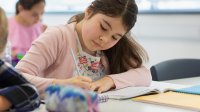3 Strategies to Help Students Move From Start to Finish in PBL
Between the launch of a project-based learning unit and the final presentation, targeted instruction and feedback are crucial for student success.
Your content has been saved!
Go to My Saved Content.The project launch and the project presentation are two unique aspects of the project-based learning (PBL) methodology. The former is the time for presenting a formidable challenge that students will need to solve. The latter is the culminating experience where students solve a problem, perform, or share their product.
Akin to coaches presenting to athletes the importance of competing against the rival swim team and then competing in the meet, project launches and presentations are engaging bookends to the challenging work that has to occur in between such events.
The time in between the launch and the end is all about preparation. Here students need to develop and refine core knowledge and skills to answer the PBL problem and prepare for the culminating presentation.
3 Strategies to Prepare Students for the Middle of PBL
1. Direct instruction. When students are first learning something, they need direct input, frequent checks for understanding, guided practice, and opportunities for independent practice. While parts of a project require teachers to take more of an inquiry stance, the middle is associated with teachers taking an active role by providing targeted instruction and feedback.
As students progress, direct instruction strategies should broaden to greater levels of collaboration among students and with teachers. Whereas initial input was designed to enable students to know facts and ideas, later instruction is focused on consolidating information into key principles and practices of a discipline.
The same is true for feedback. More direct, targeted feedback in the early stages of learning followed by more collaborative strategies where students are frequently assessing each other’s work enable students to have the knowledge and skills they need to face the more challenging tasks and questions awaiting them at the end of the project.
Key direct instruction action steps:
- Early direct instruction should be linked to ensuring that students learn key facts and skills, which include direct modeling, spaced practice, and targeted teacher-led feedback.
- Later direct instruction should be linked to consolidating facts and skills to better understand the underlying principles of the subject. Practices should include collaborative activities that involve student and teacher discussions (e.g., Socratic seminar, jigsaw).
- As students develop proficiency in the basic level of knowledge and skills, feedback should shift to a much more shared enterprise between students and teachers where students are giving and receiving feedback from their peers, and teachers are ensuring accuracy while monitoring and managing the feedback processes.
2. Monitoring learning progress. In a swimming practice, swimmers are constantly monitoring their pace by looking at a clock and assessing if their technique and effort are at the level needed to sustain or improve performance. Students need to do the same in the middle of the project. Evaluating their own work relative to work samples, comparing their own previous drafts to current drafts to denote progress, and reflecting on performance data are all key steps that students should take to improve their skills in taking responsibility for their own learning.
Key monitoring learning progress steps:
- Provide students with multiple work examples to evaluate levels of performance.
- Ensure that students keep drafts or copies of their iterative work so they can compare and contrast the differences in their performance.
- Set up a time and a process for students to reflect on their performance and next steps they need to take in light of performance data.
3. Reading, writing, and talking tasks. The best way for swimmers to get better is through practices that require a focus on technique, endurance, and speed. In the PBL classroom, students need to develop their thinking through cognitive tasks that are laden with academic reading, writing, and talking (as opposed to cutting, pasting, and scrolling). Moreover, those tasks should be centered on building student knowledge in the discipline.
One way to link these three cognitive tasks together is to use methods or protocols that require all three sequentially. For example, in the Four As protocol, students are tasked with reading an article or passage, writing a reflection or addressing a set number of questions related to the article or passage, and then discussing the article and their reflection with others.
Key reading, writing, and talking tasks:
- Provide students with reading, writing, and talking work samples, and ask students to discuss the key reasons that the samples are exemplary. Students should then use these reasons to build a rubric or success criteria to monitor their own work over time.
- Select protocols that enable students to give and receive feedback on reading, writing, and talking tasks. These feedback protocols include the tuning protocol, critical friends, and the consultancy protocol.
- Ensure that students are developing learning strategies that enable them to navigate reading, writing, and talking tasks, including concept mapping, outlining, underlining and highlighting, and note-taking.
